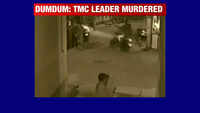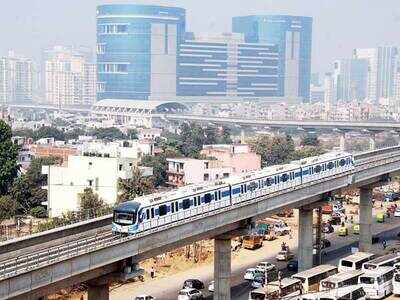
Gurgaon may want you to ditch your car, but residents say that in the absence of a robust public transport system, they do not have any option left
It was in 2015 that Gurgaon pushed for increased use of alternative transport with the Car Free Day initiative that was later adopted by several other cities. Over the years, the Millennium City and its residents have been at the forefront of promoting alternative and public transport options in a bid to reduce the harmful impact of vehicular pollution. However, the absence of a robust public transport system in the city and administrative apathy means the implementation of these schemes is often always down to individuals.
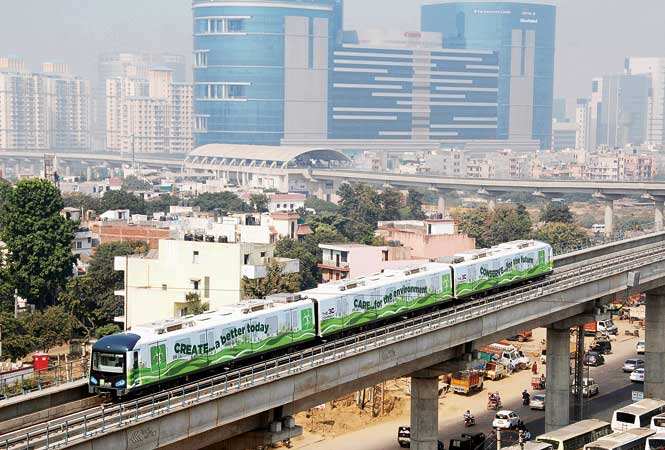
Last month, an unexpected disruption in the services of the Delhi Metro’s Yellow Line on the Delhi-Gurgaon border caused widespread chaos. Several people had to walk large distances in the heat, in the absence of alternative transport and jams on the Gurgaon-Delhi routes stretched out to miles. For many, it underlined the problem of Gurgaon’s dormant public transport system. Rakesh Singh, a banker who lives in Sector 63, says, “The problem with Gurgaon is that there aren’t any alternatives if we want to ditch our cars. Despite all the initiatives that call for public transport usage, it is not possible. In Delhi, any combination of buses and metro will get you from one place to another, but in Gurgaon, there are large gaps in that network. For instance, my sector isn’t connected via public transport at all even though thousands of families live here.”
While there are private initiatives which aim to solve the issue of last mile connectivity – like an app-based, dockless bike-sharing service – the absence of bicycle tracks, is a major problem
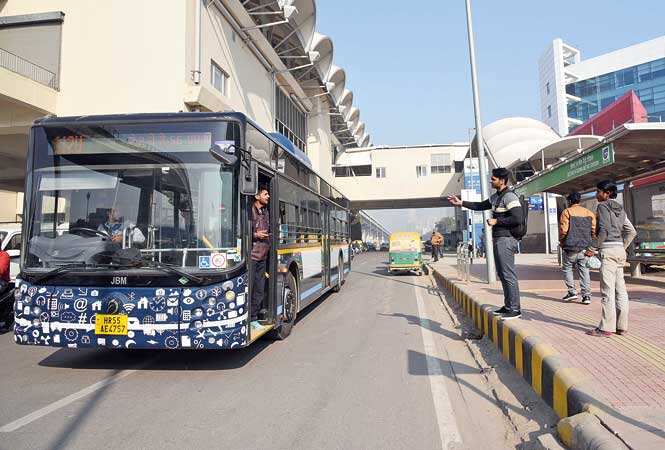 Residents say that the bus routes are very limited
Residents say that the bus routes are very limited
It is not as if there is absence of public transport modes in the city. It’s just that they aren’t used widely enough. The Gurgaon Rapid Metro was launched in 2013 and its first phase was expected to ferry one lakh passengers daily. Till 2018, the actual ridership however hovered between 30,000 and 35,000 only. With the launch of the second phase last year, the average daily ridership of the metro has increased to 50,000 but it still remains grossly underutilised. Numbers from the Gurgaon Rapid Metro and the Delhi Metro show that Gurgaon Rapid Metro’s average ridership is only half that of its Delhi counterpart. Similarly, Gurgaon’s city bus service – called Gurugaman – currently operates on six routes, expanded from two when it was launched in August last year. As per the Gurugram Metropolitan City Bus Limited (GMCBL), the civic body that operates these buses, the total daily ridership on the 81 buses along these six routes is just over 25,000. That translates to about 300 passengers per bus on a daily basis. In comparison, the DTC buses carry around 750 passengers per bus every day.
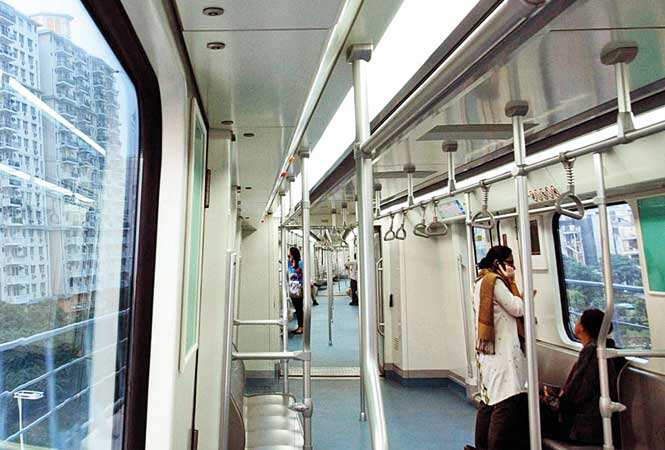 The rapid metro, which was expected to daily ferry one lakh passengers when it was launched, has remained, till date, massively underutilised
The rapid metro, which was expected to daily ferry one lakh passengers when it was launched, has remained, till date, massively underutilised
Commuters in the city attribute this reluctance in using the city’s existing public service modes to factors like cost-effectiveness, last-mile connectivity, and improper route planning. Avantika Kumar, who commutes from Delhi to Gurgaon every day for work, tells us, “The biggest problem with the bus service in Gurgaon is accessibility. The last mile connectivity is abysmal and the routes are very limited. That means you can’t ditch your car and expect the bus to take you wherever you want in the city. My office is in Udyog Vihar and I would love to take the bus but the 10-15 minute waiting time and the fact that it drops me far from my office deter me.”
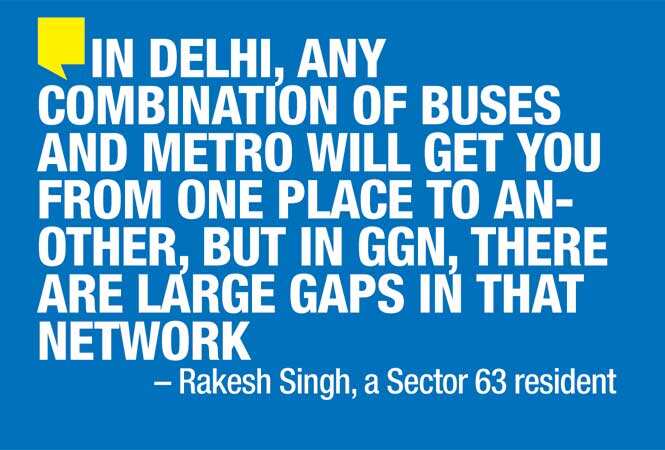
Vartika Singh, a Sector 43 resident, adds, “On one hand, the Delhi Metro might soon be free for women but Gurgaon Rapid Metro continues to be expensive. Even without any freebies, the fare in Delhi Metro is effectively half that of Gurgaon over similar distances. That is the biggest deterrent in using it. I would rather drive that distance as that would be cheaper.”
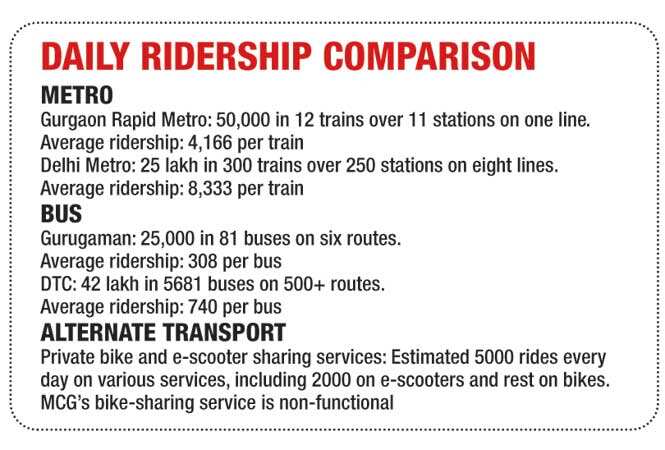
Cyclists have their own share of challenges in the city
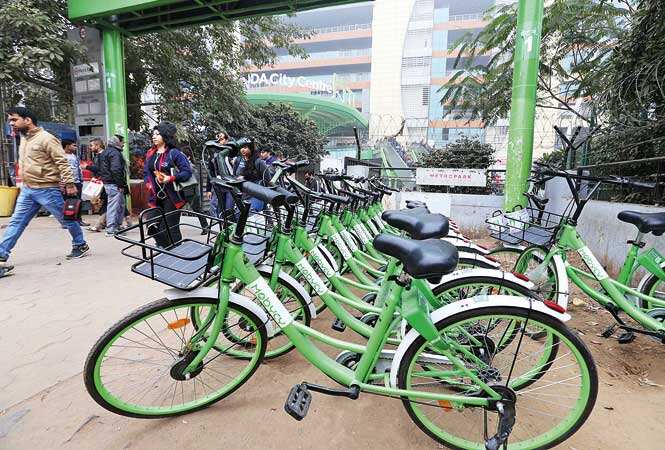
The problem of last mile connectivity is in part being tackled by private initiatives and individuals themselves. Launched in December 2017, Mobycy, NCR’s only app-based, dockless bike-sharing service continues to expand its network in the city. Akash Gupta, founder of the company, tells us, “We started with 50-100 bikes and have now expanded to 2000 in all of Gurgaon. From just over 200 rides per day when we began, we have increased to about 2000 now. Our bikes are available at metro stations, bus stands, and close to major offices.” The service has tie-ups with Rapid Metro, GMDA, MCG, and major corporate players like DLF and Nagarro for last mile connectivity. However, bicycles have their own shares of challenges in the city, particularly traffic. Vikas Singh, a Gurugrammer who cycles to work, tells us, “There are no bicycles tracks in the city. Most of the roads to offices are either wide or main highways, so the traffic moves fast. All this makes it very difficult for the cyclists in the city. It is always risky to cycle in Gurgaon during rush hour but many people still do it in their individual capacity. Any initiative being undertaken by residents for alternative transport is being done individually, without institutional support.” The MCG had started its own bike sharing service in 2016 with stands at major Metro stations but it lies dormant. The bikes haven't been used in years now. Even companies are taking note of the cyclists’ difficulties and shifting focus. This year, Mobycy also launched an e-scooter service and the company says it is now shifting its focus from bicycles to scooters. “E-scooters are a better fit for Gurgaon because there is an absence of dedicated bike lanes in the city. Then, in the harsh summer months, people don't want to cycle,” says Gupta.
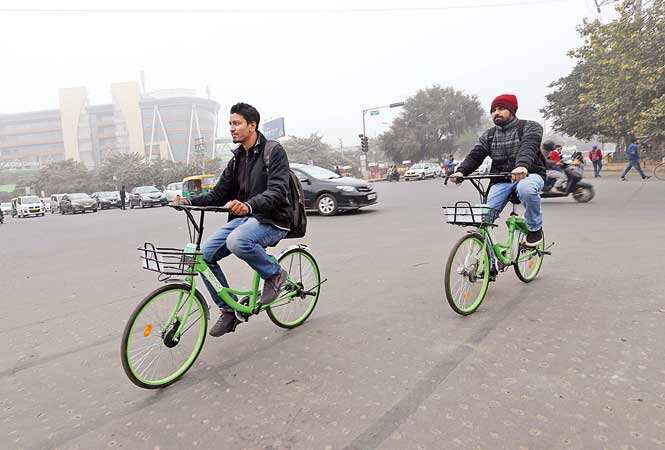 While there are private initiatives which aim to solve the issue of last mile connectivity – like an app-based, dockless bike-sharing service – the absence of bicycle tracks, is a major problem
While there are private initiatives which aim to solve the issue of last mile connectivity – like an app-based, dockless bike-sharing service – the absence of bicycle tracks, is a major problem
It was in 2015 that Gurgaon pushed for increased use of alternative transport with the Car Free Day initiative that was later adopted by several other cities. Over the years, the Millennium City and its residents have been at the forefront of promoting alternative and public transport options in a bid to reduce the harmful impact of vehicular pollution. However, the absence of a robust public transport system in the city and administrative apathy means the implementation of these schemes is often always down to individuals.

Last month, an unexpected disruption in the services of the Delhi Metro’s Yellow Line on the Delhi-Gurgaon border caused widespread chaos. Several people had to walk large distances in the heat, in the absence of alternative transport and jams on the Gurgaon-Delhi routes stretched out to miles. For many, it underlined the problem of Gurgaon’s dormant public transport system. Rakesh Singh, a banker who lives in Sector 63, says, “The problem with Gurgaon is that there aren’t any alternatives if we want to ditch our cars. Despite all the initiatives that call for public transport usage, it is not possible. In Delhi, any combination of buses and metro will get you from one place to another, but in Gurgaon, there are large gaps in that network. For instance, my sector isn’t connected via public transport at all even though thousands of families live here.”
While there are private initiatives which aim to solve the issue of last mile connectivity – like an app-based, dockless bike-sharing service – the absence of bicycle tracks, is a major problem

It is not as if there is absence of public transport modes in the city. It’s just that they aren’t used widely enough. The Gurgaon Rapid Metro was launched in 2013 and its first phase was expected to ferry one lakh passengers daily. Till 2018, the actual ridership however hovered between 30,000 and 35,000 only. With the launch of the second phase last year, the average daily ridership of the metro has increased to 50,000 but it still remains grossly underutilised. Numbers from the Gurgaon Rapid Metro and the Delhi Metro show that Gurgaon Rapid Metro’s average ridership is only half that of its Delhi counterpart. Similarly, Gurgaon’s city bus service – called Gurugaman – currently operates on six routes, expanded from two when it was launched in August last year. As per the Gurugram Metropolitan City Bus Limited (GMCBL), the civic body that operates these buses, the total daily ridership on the 81 buses along these six routes is just over 25,000. That translates to about 300 passengers per bus on a daily basis. In comparison, the DTC buses carry around 750 passengers per bus every day.

Commuters in the city attribute this reluctance in using the city’s existing public service modes to factors like cost-effectiveness, last-mile connectivity, and improper route planning. Avantika Kumar, who commutes from Delhi to Gurgaon every day for work, tells us, “The biggest problem with the bus service in Gurgaon is accessibility. The last mile connectivity is abysmal and the routes are very limited. That means you can’t ditch your car and expect the bus to take you wherever you want in the city. My office is in Udyog Vihar and I would love to take the bus but the 10-15 minute waiting time and the fact that it drops me far from my office deter me.”

Vartika Singh, a Sector 43 resident, adds, “On one hand, the Delhi Metro might soon be free for women but Gurgaon Rapid Metro continues to be expensive. Even without any freebies, the fare in Delhi Metro is effectively half that of Gurgaon over similar distances. That is the biggest deterrent in using it. I would rather drive that distance as that would be cheaper.”

Cyclists have their own share of challenges in the city

The problem of last mile connectivity is in part being tackled by private initiatives and individuals themselves. Launched in December 2017, Mobycy, NCR’s only app-based, dockless bike-sharing service continues to expand its network in the city. Akash Gupta, founder of the company, tells us, “We started with 50-100 bikes and have now expanded to 2000 in all of Gurgaon. From just over 200 rides per day when we began, we have increased to about 2000 now. Our bikes are available at metro stations, bus stands, and close to major offices.” The service has tie-ups with Rapid Metro, GMDA, MCG, and major corporate players like DLF and Nagarro for last mile connectivity. However, bicycles have their own shares of challenges in the city, particularly traffic. Vikas Singh, a Gurugrammer who cycles to work, tells us, “There are no bicycles tracks in the city. Most of the roads to offices are either wide or main highways, so the traffic moves fast. All this makes it very difficult for the cyclists in the city. It is always risky to cycle in Gurgaon during rush hour but many people still do it in their individual capacity. Any initiative being undertaken by residents for alternative transport is being done individually, without institutional support.” The MCG had started its own bike sharing service in 2016 with stands at major Metro stations but it lies dormant. The bikes haven't been used in years now. Even companies are taking note of the cyclists’ difficulties and shifting focus. This year, Mobycy also launched an e-scooter service and the company says it is now shifting its focus from bicycles to scooters. “E-scooters are a better fit for Gurgaon because there is an absence of dedicated bike lanes in the city. Then, in the harsh summer months, people don't want to cycle,” says Gupta.

World Cup 2019
Trending Topics
LATEST VIDEOS
More from TOI
Navbharat Times
Featured Today in Travel
Quick Links
Lok Sabha Election Schedule 2019Lok Sabha Election NewsDelhi Capitals teamMI team 2019Rajasthan Royals 2019RCB team 2019Maharashtra Lok Sabha ConstituenciesBJP Candidate ListBJP List 2019 TamilnaduShiv Sena List 2019AP BJP List 2019Mamata BanerjeeBJP List 2019 MaharashtraPriyanka GandhiBJP List 2019 KarnatakaAMMK Candidate List 2019BJP List 2019 WBLok Sabha Elections in Tamil NaduBSP List 2019 UPNews in TamilLok Sabha Poll 2019Satta Matka 2018PM ModiMahagathbandhanNagpur BJP Candidate ListChandrababu NaiduTamil Nadu ElectionsUrmila MatondkarNews in TeluguMadras High CourtTejashwi YadavArvind KejriwalTejasvi SuryaPawan KalyanArvind KejriwalYogi AdityanathJaya PradaSatta King 2019Srinagar encounter
Get the app

